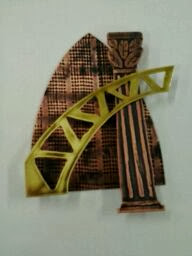This week in my ceramics workshop we were told that we were going to make clay insects and learn a technique called extruding. However before we learnt the technique we had to get the basic shape of our insects made.
Clay spider half done
First I had to make the body of my insect this was done by getting two lumps of clay and making a ball shape with it, after that I pushed a hole into the center and pinched the sides so both pieces formed a dome shape. Then I stuck both domes together to form a ball by cross hatching the joins and painting water onto it to make it sticky. The only thing I had to do then was put a hole in the ball so it wouldn't com bust in the kiln. This made the body of my insect, next next was to make the legs.
To make the legs of my insect I had to use the extruding technique. Extruding is the process in which clay is forced through dies to produce elongated shapes. To make the legs I used a circular die to press the clay through and then I cut the clay up to shape and stick onto my insect.
Clay spider
I put texture onto my spider to make it seem furry and I put some small details on like the lips, fangs and eyes so it had some unrealistic features. It was really entertaining to make and it is brilliant for my first time making a insect especially because it looks so real.
Clay bee from the front
I also had time during the lesson to make a second insect this been a clay bee. I didn't have as much time on this insect so there isn't much texture on the surface but it was definitely more difficult to make than the spider. This insect was inspired by my nature mood board because of the close-up of the beehive and I think it helps tie the ceramics work and nature project together.
Clay bee from the side
I am actually impressed that I have made such a realistic looking bee/wasp even though it is a enlarged version. I would have maybe liked to put some more texture onto it but I am still happy with how it looks. Next week I will be making clay tiles so look out for next weeks update x














